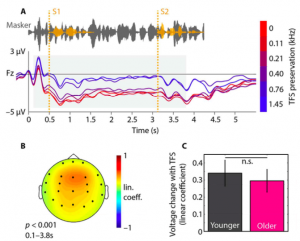In these last months of 2014, I am spending a few weeks in New York and the East Coast. Thanks to my generous host Peter Lakatos at the NKI and pampered by the marvellous Erasmus Mundus program initiated by Rudolf Ruebsamen and Marc Schoenwiesner, I am fortunate to explore with Peter a comparative view on the role of alpha oscillations in auditory cortex and in thalamo-cortical circuits.
This stay essentially sandwiches a productive visit to the Society for Neuroscience 2014 meeting in DC a few weeks ago, where our group presented four posters this year.
Also, it has been a great honour to be awarded the Young Investigators Spotlight talk at this year’s APAN meeting (an annual auditory-neuroscience SfN satellite). Invitations to the labs of David Poeppel (for the impressive annual BryCoCo bash); Barbara Shinn-Cunningham, Oded Ghitza, and Steve Colbourn (at the Boston Hearing Research Center) and to the lab of Sabine Kastner (Princeton Neuroscience Institute) have rendered this stay highly memorable before it is even over.
Tag: Obleser
Congratulation to PhD student Malte Wöstmann, who – with Erich Schröger and Jonas Obleser – has a new article in press at the Journal of Cognitive Neuroscience
Acoustic detail guides attention allocation in a selective listening task
forthcoming. We will update you accordingly as the paper comes online. We will share however one of Malte’s figures here as a teaser: The paper utilises a very classic component of the evoked potential, the contingent negative variation (the CNV; or a close relative thereof, see the actual paper for discussion) to study how older and younger listeners allocate their attentional resources depending on implicit cues on to-be-expected listening difficulties.
References
- Wöstmann M1, Schröger E, Obleser J. Acoustic Detail Guides Attention Allocation in a Selective Listening Task. J Cogn Neurosci. 2014 Nov 12:1–13. PMID: 25390200. [Open with Read]
Congratulations to Auditory Cognition’s very own Molly Henry who, with Björn Herrmann and Jonas Obleser, is about to publish yet another PNAS paper:
Entrained neural oscillations in multiple frequency bands co-modulate behavior
Henry MJ, Herrmann B, & Obleser J. PNAS, in press.
We are very excited about this one, as it harks back to Molly’s 2012 PNAS paper yet ups the ante somewhat: How do neural oscillations behave towards a more realistically complex mixture of acoustic regularities, and how does listening behaviour change as a function of various neural entrained phases?
Stay tuned until after PNAS embargo has been lifted!
[UPDATE]PNAS paper is online. Check it out here.
References
- Henry MJ1, Herrmann B2, Obleser J1. Entrained neural oscillations in multiple frequency bands comodulate behavior. Proc Natl Acad Sci U S A. 2014 Oct 14;111(41):14935–40. PMID: 25267634. [Open with Read]
In a collaboration with the University Clinic of Leipzig and Prof Dr Gesa Hartwigsen (now University of Kiel), a new paper is to appear in “Cortex”, in the forthcoming special issue on Prediction in Speech and Language, edited by Alessandro Tavano and AC alumnus Mathias Scharinger.
Hartwigsen G, Golombek T, & Obleser J.
Check it out soon!
References
- Hartwigsen G1, Golombek T2, Obleser J3. Repetitive transcranial magnetic stimulation over left angular gyrus modulates the predictability gain in degraded speech comprehension. Cortex. 2014 Sep 18. PMID: 25444577. [Open with Read]
Dr Björn Herrmann did it again, and is in press at NeuroImage with Herrmann, Henry, Scharinger, & Obleser on
References
- Herrmann B1, Henry MJ2, Scharinger M2, Obleser J2. Supplementary motor area activations predict individual differences in temporal-change sensitivity and its illusory distortions. Neuroimage. 2014 Jul 23;101C:370–379. PMID: 25064666. [Open with Read]
Hooray for Dr. des. Julia Erb …
… the first PhD student from the Auditory Cognition group, started in January 2011, to defend her PhD (Dr. rer. nat.) thesis.
Julia presented her work last thursday to the defense committee, and will now move on to a great Postdoc position – it seems she will have a hard choice between two great options.
Thank you Julia for the great science and the great fun you brought to the lab! And thanks to the external examiner as well as to Erich Schröger and all committee members at the University of Leipzig, who kindly collaborate on graduating our students.
We wish you all the best
-Members of AC
Congratulations to Obleser lab alumnus Mathias Scharinger who this week published our joint work on simultaneous fMRI–EEG in Frontiers in Human Neuroscience!
Simultaneous EEG-fMRI brain signatures of auditory cue utilization
by Scharinger, Herrmann, Nierhaus, & Obleser
References
- Scharinger M1, Herrmann B1, Nierhaus T2, Obleser J1. Simultaneous EEG-fMRI brain signatures of auditory cue utilization. Front Neurosci. 2014 Jun 4;8:137. PMID: 24926232. [Open with Read]
It’s only a week ago that we updated you about Antje’s latest publication at NeuroImage. Today, there is a another one coming in; Antje’s, Malte’s & Jonas’ perspective article on cortical alpha oscillations is in press at frontiers in HUMAN NEUROSCIENCE.
Cortical alpha oscillations as a tool for auditory selective inhibition
— Strauß, Wöstmann & Obleser
References
- Strauß A1, Wöstmann M2, Obleser J1. Cortical alpha oscillations as a tool for auditory selective inhibition. Front Hum Neurosci. 2014 May 28;8:350. PMID: 24904385. [Open with Read]


